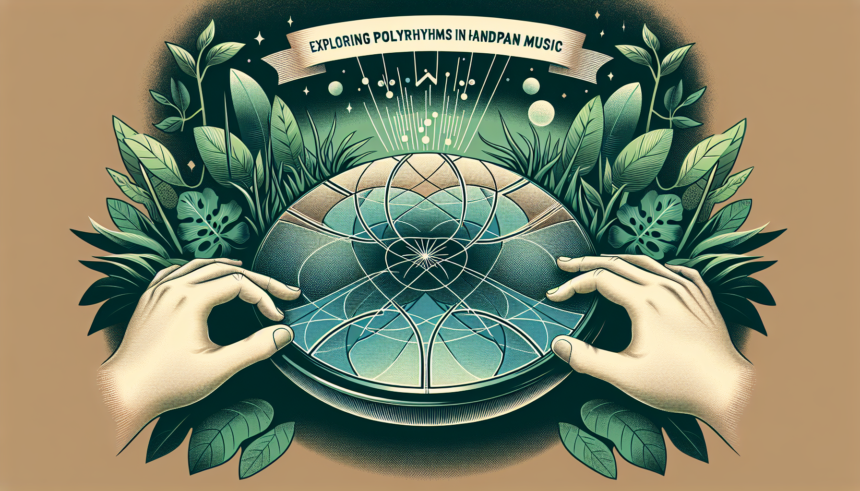Handpans, with their evocative, melodic sounds, have captured the hearts of musicians and listeners alike since their inception. One of the fascinating aspects of handpan music is the use of polyrhythms—a complex and intriguing rhythmic structure that adds depth and dimension to compositions. In this article, we will explore the concept of polyrhythms in handpan music, understanding what they are, how they are utilized, and their impact on creating captivating musical experiences.
Understanding Polyrhythms
Polyrhythms are a musical technique in which two or more rhythms with different meters or beats are played simultaneously. This can create intricate and layered rhythmic patterns that challenge the listener’s perception of time and beat. The most common example of a polyrhythm is the 3:2 polyrhythm, where one rhythm is in triple meter while the other is in duple meter.
In classical Western music, polyrhythms are less prevalent, but they are a staple in African, Latin, and Indian music traditions. Handpan music, being a relatively new form, draws from these diverse traditions and often incorporates polyrhythms to create rich, textured soundscapes.
The Handpan: A Unique Instrument
The handpan is a steel drum-like instrument that produces harmonious and soothing sounds. It consists of a central note (the ‘ding’) and surrounding tone fields that are tuned to different pitches. The instrument’s design allows for both melody and percussion, making it ideal for exploring rhythmic complexities like polyrhythms.
Handpans are typically played with the hands, and the player’s technique can drastically affect the sound produced. This tactile aspect allows for a vast range of expressive possibilities, including the intricate layering of rhythms that polyrhythms demand.
Incorporating Polyrhythms in Handpan Music
Incorporating polyrhythms into handpan music can be both challenging and rewarding. It requires a strong sense of timing and an ability to maintain multiple rhythmic patterns simultaneously. Here are some methods handpan players use to achieve polyrhythms:
Layering Rhythms
One approach to playing polyrhythms on the handpan is to layer rhythms by using different parts of the instrument. For example, a player might use the left hand to maintain a steady beat on one tone field while the right hand plays a contrasting rhythm on another tone field. This creates a multi-dimensional rhythmic experience that is continuously dynamic and evolving.
Interactive Phrasing
Another technique involves interactive phrasing, where the player shifts between different rhythm patterns within a single phrase. This approach requires the musician to have a deep understanding of the timing and structure of each rhythm and the ability to transition smoothly between them.
Using Loop Pedals
Loop pedals are electronic devices that allow musicians to record a segment of music and then play it back on a loop. Handpan players can use loop pedals to create layers of rhythm and melody, enabling them to experiment with polyrhythms more freely. By recording one rhythm and then playing a different one on top of it, musicians can explore complex rhythmic structures that would be difficult to achieve in a live, unassisted performance.
The Impact of Polyrhythms on Handpan Music
Polyrhythms bring several benefits and unique qualities to handpan music. Here are a few significant impacts:
Enhanced Expressiveness
Polyrhythms add layers of complexity and emotion to handpan music, allowing for greater expressiveness. The interplay between different rhythms can evoke feelings of tension, release, surprise, and anticipation, making the music more engaging and emotionally impactful.
Textural Depth
The juxtaposition of multiple rhythms creates a rich tapestry of sound. This textural depth gives handpan music a unique, immersive quality, drawing listeners into the intricate world of rhythms and melodies woven together in unexpected ways.
Rhythmic Versatility
By experimenting with polyrhythms, handpan players can develop a versatile approach to rhythm. This versatility not only enhances their musical skillset but also opens up new avenues for creativity and innovation in their compositions.
Cross-Cultural Connections
Polyrhythms are an essential aspect of many musical traditions around the world. By incorporating these rhythms, handpan music can bridge cultural gaps and create connections between different musical styles and histories. It can pay homage to the rhythmic traditions of Africa, India, Latin America, and other regions while creating something entirely new and unique.
Challenges and Techniques for Mastering Polyrhythms
Mastering polyrhythms on the handpan is no small feat. It requires dedication, practice, and a deep understanding of rhythm. Here are some techniques and tips for musicians looking to incorporate polyrhythms into their handpan playing:
Start Simple
Begin with simple polyrhythms, such as 3:2 or 4:3, before progressing to more complex structures. This allows you to build a solid foundation and get comfortable with the coordination required to maintain multiple rhythms simultaneously.
Use a Metronome
A metronome can be an invaluable tool for practicing polyrhythms. Set the metronome to a steady beat and practice aligning different rhythms to this beat. This helps to develop a strong internal sense of timing.
Break it Down
Break down complex polyrhythms into smaller, more manageable parts. Practice each part separately before combining them. This incremental approach makes it easier to understand and internalize the different rhythmic components.
Clap and Count
Clapping and counting out loud can help solidify your understanding of polyrhythms. This physical and auditory reinforcement can make it easier to grasp and reproduce complex rhythms on the handpan.
Listen and Analyze
Listen to music that incorporates polyrhythms and try to analyze the rhythmic structures. This can provide inspiration and insight into how different rhythms interact and complement each other. Pay attention to handpan recordings that feature polyrhythms and observe the techniques used by skilled players.
Conclusion
Polyrhythms add a captivating layer of complexity and expressiveness to handpan music. By incorporating multiple rhythms into their playing, handpan musicians can create rich, textured soundscapes that engage and mesmerize listeners. While mastering polyrhythms presents its challenges, the rewards are well worth the effort. With dedication, practice, and a deep appreciation for rhythm, musicians can unlock new dimensions of creativity and artistry in their handpan compositions. As the world of handpan music continues to evolve, polyrhythms will undoubtedly remain a significant and inspiring element.
FAQs
1. What are polyrhythms in handpan music?
Polyrhythms in handpan music refer to the simultaneous use of two or more different rhythms or meters. This creates complex and layered rhythmic structures that add depth and texture to the music.
2. How can I start practicing polyrhythms on the handpan?
Start with simple polyrhythms (e.g., 3:2 or 4:3) and practice with a metronome. Break down the rhythms into smaller parts, clap and count them out, and gradually combine them as you become more comfortable.
3. Are polyrhythms common in handpan music?
While polyrhythms are not ubiquitous in handpan music, they are used by many skilled players to add complexity and expressiveness to their compositions. Handpan music’s versatility makes it well-suited for exploring such intricate rhythms.
4. Can I use a loop pedal to create polyrhythms on the handpan?
Yes, a loop pedal is a useful tool for creating polyrhythms. By recording different rhythmic layers and playing them back simultaneously, you can experiment with complex rhythmic patterns in your handpan music.
5. What is the benefit of incorporating polyrhythms in handpan music?
Polyrhythms enhance the expressiveness, textural depth, rhythmic versatility, and cross-cultural connections in handpan music. They add a unique dimension that engages listeners and expands the creative possibilities for musicians.





